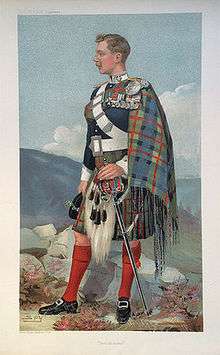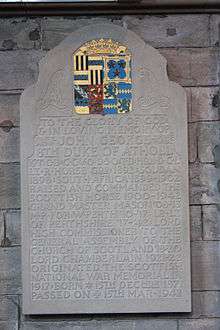John Stewart-Murray, 8th Duke of Atholl
| The Duke of Atholl | |
|---|---|
 Vanity Fair caricature by Spy (Leslie Ward), 23 March 1905. | |
| Nickname(s) | Bardie (short for Tullibardine) |
| Born |
15 December 1871 Blair Castle, Perthshire |
| Died | 16 March 1942 (aged 70) |
| Allegiance |
|
| Service/branch |
|
| Rank | Brigadier General |
| Unit |
Royal Horse Guards Scottish Horse |
| Commands held | The Scottish Horse Brigade |
| Battles/wars |
Battle of Khartoum Battle of Atbara Second Boer War First World War |
| Awards |
Knight of the Order of the Thistle Knight Grand Cross of the Royal Victorian Order Companion of the Order of the Bath Distinguished Service Order |
| Other work |
Unionist Member of Parliament Lord Chamberlain |
Brigadier General John George Stewart-Murray, 8th Duke of Atholl KT, GCVO, CB, DSO, PC, ADC (15 December 1871 – 16 March 1942), styled Marquess of Tullibardine until 1917, was a Scottish soldier and Unionist politician.
Early life
Styled Marquess of Tullibardine from birth, he was born at Blair Castle, Perthshire, the second but eldest surviving son of John Stewart-Murray, 7th Duke of Atholl, by Louisa, daughter of Sir Thomas Moncreiffe of that Ilk, 7th Baronet.[1] and was educated at Eton College.[1]He learned to speak Gaelic before English. In "Working Partnership" his wife, The Duchess of Atholl, says that Tullibardine and all his siblings were brought up to speak Gaelic and were "extremely proficient" in it. He was President of An Comunn Gàidhealach, the national Gaelic Society, from 1898 until 1904.
Military career
Service in the Royal Horse Guards
He was commissioned into the Royal Horse Guards with the rank of second lieutenant on 28 December 1892, and was promoted to lieutenant on 30 December 1893. He served in Kitchener's expedition to the Sudan, fighting at the Battle of Khartoum and the Battle of Atbara. He was awarded the Distinguished Service Order (DSO) on 15 November 1898, and rose to the rank of captain a year later, on 20 November 1899.[2]
Second Boer War
In 1900 he served as an aide-de-camp to Brigadier-General J. F. Burn-Murdoch, in command of a brigade of the Cavalry division stationed in Natal. In November 1900 he was given the rank of brevet major in the Royal Horse Guards,[3] and asked by Lord Kitchener, whom he had served under on the Omdurman Campaign, to raise a regiment of Scotsmen in South Africa, called The Scottish Horse. The regiment was raised quickly and soon saw active service in the Western Transvaal. A second regiment of Scottish Horse was raised from troops recruited by The 7th Duke of Atholl and a permanent headquarters was set up to supply both of these regiments, with Atholl in command but with subordinate commanding officers in the field in charge of each of the Regiments. This success continued until the Scottish Horse was a whole brigade by the end of the Second Boer War. In August 1901 Lord Tullibardine received the local rank of lieutenant colonel in South Africa while commanding the Scottish Horse,[4] and in 1903 he was promoted to the substantive rank of lieutenant colonel in the Army. The following year he was appointed a Member of the Royal Victorian Order (MVO).
First World War
In the Great War Atholl commanded a Brigade of a Yeomanry Regiment and took them to fight dismounted (without horses) in the Dardanelles campaign against the Turks. He gained the rank of temporary brigadier general in 1918.
Further service
During the Second World War, despite being seventy years old, Atholl joined the Home Guard and reportedly took turns as sentry officer on duty in Whitehall. He remained closely involved with the Scottish Horse, remaining in the post of Colonel Commandant until 1919 and Honorary Colonel from 1920 until his death in 1942. He was key in establishing a Scottish National War Memorial[5] in Edinburgh Castle after the First World War and his papers relating to this are retained by the National Library of Scotland.[6]
Political career
As Marquess of Tullibardine, Atholl was elected as Unionist Member of Parliament for West Perthshire at the January 1910 general election and served in the Commons until 1917, when he succeeded his father and took his seat in the House of Lords as the 8th Duke of Atholl.[1][7] In 1918 he was made a Knight of the Order of the Thistle,[8] and then served as Lord High Commissioner to the General Assembly of the Church of Scotland until 1920.[1] In November 1921 he was sworn of the Privy Council[9] and appointed Lord Chamberlain of the Household by David Lloyd George,[10] a post he held until the coalition government fell in October of the following year.[11]

Apart from his military and political careers Atholl served as Grand Master of Scottish Freemasons between 1908 and 1913 and as an Aide-de-camp to King George V between 1920 and 1931. He was granted the Freedom of the City of Edinburgh. According to his wife's autobiography Working Partnership (1958), Atholl was considered a possible contender for the crown of Albania after a chance meeting with a delegation in Florence who were impressed with his personality.[12]
Lottery
In 1932 Atholl came to national attention when he launched a lottery in an attempt to stop money going overseas to the Irish Free State Hospitals Sweepstakes. The money this scheme raised was given to British charities, mainly hospitals, but in 1933 he was prosecuted by the Director of Public Prosecutions, Sir Edward Hale Tindal Atkinson, for promoting an unlawful lottery. Despite this, Atholl's lottery activities were admired and seen by many British people as being patriotic.[13]
Family life
While still Marquess of Tullibardine, Atholl married Katharine Ramsay, daughter of Sir James Ramsay, 10th Baronet, at St Margaret's Church, Westminster, on 20 July 1899. His wife went on to have a long political career in her own right in local government, in the House of Commons, and as a government minister.[14] They had no children. Atholl died on 16 March 1942, aged 70, and was succeeded by his youngest brother, James Stewart-Murray. His widow, Katharine, Duchess of Atholl, died in October 1960, aged 85.[1]
References
- 1 2 3 4 5 thepeerage.com Lt.-Col. Sir John George Stewart-Murray, 8th Duke of Atholl
- ↑ The London Gazette: no. 27168. p. 1255. 23 February 1900.
- ↑ The London Gazette: no. 27359. p. 6304. 27 September 1901.
- ↑ The London Gazette: no. 27358. p. 6229. 24 September 1901.
- ↑ SNWM Website
- ↑ http://195.153.34.9/catalogue/details.aspx?st=1&reference=GB233/Acc.4714
- ↑ leighrayment.com House of Commons: Paddington to Platting
- ↑ The London Gazette: no. 30723. p. 6524. 31 May 1918.
- ↑ The London Gazette: no. 32525. p. 9241. 22 November 1921.
- ↑ The London Gazette: no. 32525. p. 9245. 22 November 1921.
- ↑ The London Gazette: no. 32770. p. 8292. 24 November 1922.
- ↑ Biography of the Duke of Atholl—worldroots.com
- ↑ "Ducal Dodge". Time Magazine. 13 November 1933. Retrieved 10 August 2008.
- ↑ Masters, Brian (1988). The Dukes. London: Frederick Muller. ISBN 0-09-173700-1.
External links
- Hansard 1803–2005: contributions in Parliament by the Duke of Atholl
| Parliament of the United Kingdom | ||
|---|---|---|
| Preceded by David Erskine |
Member of Parliament for Perthshire West January 1910 – 1917 |
Succeeded by Archibald Stirling |
| Court offices | ||
| Preceded by The Viscount Sandhurst |
Lord Chamberlain 1921–1922 |
Succeeded by The Earl of Cromer |
| Honorary titles | ||
| Preceded by The Duke of Atholl |
Lord Lieutenant of Perthshire 1917–1942 |
Succeeded by Lord Kinnaird |
| Military offices | ||
| Preceded by Regiment raised by 8th Duke of Atholl |
Colonel Commandant/ Honorary Colonel of the Scottish Horse 1901–1919 1920–1942 |
Succeeded by The Duchess of Atholl DBE DL |
| Masonic offices | ||
| Preceded by Thomas Gibson-Carmichael |
Grand Master of the Grand Lodge of Scotland 1909–1913 |
Succeeded by Robert King Stewart |
| Peerage of Scotland | ||
| Preceded by John Stewart-Murray |
Duke of Atholl 1917–1942 |
Succeeded by James Stewart-Murray |
| Peerage of the United Kingdom | ||
| Preceded by John Stewart-Murray |
Baron Glenlyon 1917–1942 |
Succeeded by James Stewart-Murray |